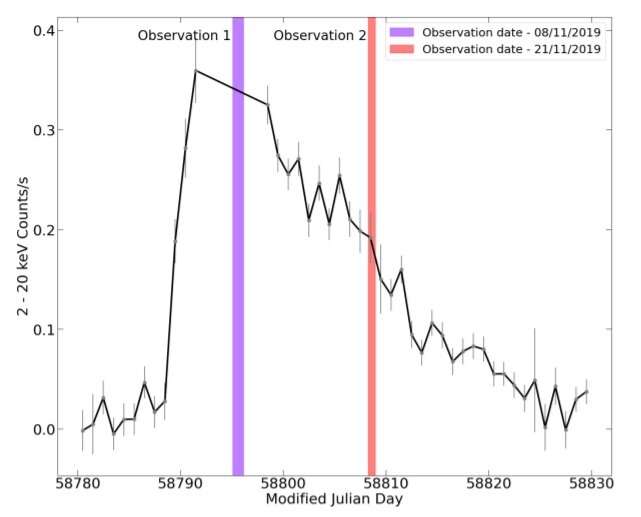1 day binned MAXI lightcurve of MAXI J0637−430 in 2 − 20 keV band. Credit: Thomas et al., 2022.
Using the AstroSat spacecraft, Indian astronomers have observed a soft X-ray transient known as MAXI J0637−430. Results of the study, published February 18 on the arXiv pre-print repository, deliver essential information regarding spectral properties of this source, what could help us unveil its true nature.
X-ray binaries are composed of a normal star or a white dwarf transferring mass onto a compact neutron star or a black hole. Based on the mass of the companion star, astronomers divide them into low-mass X-ray binaries (LMXB) and high-mass X-ray binaries (HMXB).
Soft X-ray transients (SXTs) are a subclass of LMXBs that appear as extremely faint sources during most of their lifetime. They are composed of a compact object (most commonly a black hole) and some type of low-mass main-sequence star in orbit around one another.
Observations show that SXTs experience dramatic changes in their X-ray emission, probably produced by variable transfer of mass from the normal star to the compact object. In many cases they are observed to showcase strong soft X-ray emission from an accretion disk close to the compact object. SXTs also occasionally undergo sporadic outbursts, which occur at intervals of one to sixty years. During these outbursts they are the brightest X-ray sources in the sky.
MAXI J0637−430 is an SXT detected in November 2019 by the Monitor of All-sky X-ray Image (MAXI) telescope onboard the International Space Station (ISS). Subsequent multiwavelength observations of this source have shown that it underwent an outburst and could be approaching its quiescence level. Moreover, some studies suggested that the compact object in MAXI J0637−430 is most likely a black hole.
Therefore, a group of astronomers led by Neal Titus Thomas of CHRIST (Deemed to be University) in Bengaluru, India, employed AstroSat's Soft X-ray Telescope (SXT) and Large Area X-ray Proportional Counter (LAXPC) instruments in order to shed more light on the spectral properties and nature of MAXI J0637−430.
The observations found that MAXI J0637−430 has a cool accretion disk with a temperature of about 0.55 keV and a reflection feature at 6.4 keV. The value of the photon index was measured to be greater than 2.0 and the ratio of unabsorbed disk flux to the total disk was calculated to be approximately 0.9. These results indicate that MAXI J0637−430 was in the soft spectral state when observed by AstroSat.
Furthermore, the study found that the value of the disk normalization is consistent with being constant and points to an accretion disk with an inner disk radius of the order of a few hundred kilometers. The astronomers noted that this is observed in several LMXBs with black holes, therefore, according to them this is evidence that may prove the presence of a black hole in MAXI J0637−430.
"We conclude from our study that MAXI J0637−430 is a strong black hole X-ray binary candidate. Further observations and in-depth studies of the source during its future outbursts are essential to confirm its nature and unravel other physical parameters," the researchers wrote in the paper.
More information: Neal Titus Thomas, Shivappa B. Gudennavar, Ranjeev Misra, Bubbly S. G, Spectral properties of soft X-ray transient MAXI J0637−430 using AstroSat. arXiv:2202.09083v1 [astro-ph.HE], arxiv.org/abs/2202.09083
© 2022 Science X Network
























